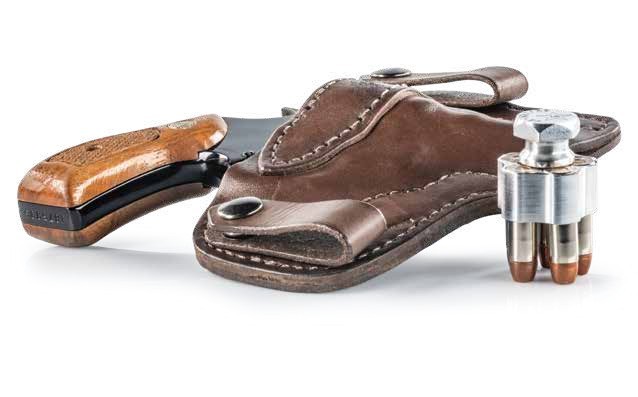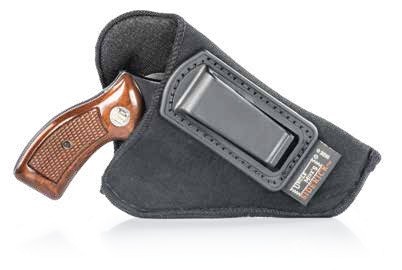‘WHY WOULD YOU CARRY THAT?’
THE ADVANTAGES OF SNUB-NOSED REVOLVERS
SCHUYLER P. ROBERTSON

AMERICAN CLASSIC
“Snubbies” like this Smith & Wesson Model 37 are just as handy today as they were a century ago.

“What do you carry?” This question is routine in circles such as ours. Some people ask it for no other reason than to advocate for their favorite firearms and aren’t concerned with what other people have to say. Many newcomers to concealed carry are genuinely seeking knowledge, and I have also come across people who have been shooting for years but are new to the idea of carrying a pistol with them every day. A Smith & Wesson .44 Magnum might be great for hunting feral hogs, but it’s not something they want to carry with them all the time. They want to be able to make good decisions, and they want to know what their best options are.
I have spent time as a deputy sheriff, and I have protected U.S. diplomats in Iraq and other designated “high-threat” areas around the globe. I have more than a passing knowledge of firearms and threat analysis. But people are sometimes surprised to learn that what I carry when I’m in the U.S. is usually a five-shot snubnosed .38 Special revolver. I routinely get asked, “Why would you carry that? You could carry [insert favorite gun] instead.”
Let’s go over some of the reasons I trust my life to this platform.
COMFORT
First off, a smaller gun is more comfortable to carry than a larger gun. I carried a full-sized 1911 concealed for years. I told myself that if I was going to carry concealed, I wanted to carry the best combat pistol out there. There is certainly logic in that kind of thinking. The problem was I didn’t always carry it.
A full-sized pistol weighs more than a smaller gun, and when it is warmer outside, you have to add layers of clothing to conceal such a pistol. There were times when I left my 1911 at home because it was too big for my outfit. And to be honest, it was sometimes just a pain to carry it with me.
If you run into trouble, a small gun on you beats the combat rifle you left at home. Some people will say that you should just force yourself to carry a bigger gun, and kudos if that’s you and you actually do it. However, if you occasionally find yourself leaving your gun at home because it’s 90 degrees outside and you don’t want to throw on another layer of clothing or because your hip has been bothering you because of the weight of your pistol, it might be time to consider getting a smaller gun that you’re guaranteed to carry all the time.
CONCEALABILITY
The whole point of concealed carry is to be able to hide your gun. Other people should not know you are carrying unless you draw. Even if you are within the law and your employer doesn’t have a policy against it, you could put your job at risk if people learn you are carrying. One woman I spoke with switched from an already very concealable 2-inch revolver to a .380 auto because she absolutely needed to conceal it at work.
“I started with a Ruger LCR .38 Special +P [hammerless revolver], but it was too bulky and heavy — Iwear scrubs to work,” she said. “I didn’t like carrying in a purse or bag, so the .38 sits on my nightstand and I carry the LCP II in a concealed holster inside my waistband.”
If your job might be at risk because you carry, you have to make sure no one knows you have that gun on you. Having it totally concealed can save you a lot of grief. The world is full of petty people who will ruin a person’s life just because they can. An anti-gun coworker might tell HR you threatened him or her just because he or she discovered you carry.
Don’t invite trouble. Keep it concealed.
PRICE TAG
Another huge factor is cost. You can still get a used J-frame-sized .38 for about $300, while the cost of some new pocket semi-autos will set you back about $600. If you haven’t bought a carry pistol yet and $500 to $600 is within your budget, then you are probably looking at getting a revolver. You’ll be spending about $300 on the gun, $100 to $150 on a quality holster and the rest on ammunition with which to train. A $600 automatic will cost you nearly $1,000 before you can carry it. (And, yes, you need to train with a gun before you carry it. Failing to do so would be irresponsible.) The $300 snub-nosed revolver you own is better than the $600 automatic for which you are still saving.
CLOSE QUARTERS
How I expect a criminal attack to transpire is another reason I carry a snubnosed revolver. By nature, criminals are ambush predators. A street criminal’s most likely course of action is to try to appear non-threatening, get as close to you as he or she can, then attack and try to catch you unaware. Based on that most-likely scenario, you would not be legally justified in drawing your firearm until the attacker was upon you. You can’t just draw your pistol because you think someone walking toward you looked at you funny. You can try to avoid him or her, but you can’t present a gun until you can explain to responding law enforcement why you drew a gun in public.
“ YOU DON’T HAVE TO WORRY ABOUT A REVOLVER GETTING PUSHED OUT OF BATTERY, AND THE SHORT BARREL ON A SNUB-NOSED REVOLVER ALSO MAKES IT LESS LIKELY AN ATTACKER CAN FORCE THE GUN OUT OF YOUR HAND. ”
In a situation where the fight is at arm’s length, a revolver beats all other options. A revolver has a short sight radius, which means less accuracy at longer ranges but faster sight acquisition at short ranges — 10 feet or less. If you are trying to fight off someone who has you backed against a car or has you on the ground and is trying to beat you to death, your sights could be useless.
There is also less that can go wrong mechanically with a revolver than with a semi-automatic. If someone is on top of you and choking you, your instinct is likely going to be to try to push your attacker away. If you have a gun in your hand, you can push the muzzle into your attacker’s body. If you have an automatic, pushing it into your attacker’s body will move the slide out of battery, and your gun will not fire. There are videos of convicts teaching each other to grab the slide of a cop’s gun to force it out of battery to disable it and then disarm the officer. You don’t have to worry about a revolver getting pushed out of battery, and the short barrel on a snub-nosed revolver also makes it less likely an attacker can force the gun out of your hand.
I have a friend who thinks snub-nosed revolvers are stupid and that everyone should carry a Glock 19 like he does. He pointed out that it is also possible to disable a revolver by grabbing the hammer or the cylinder and preventing it from moving. This is a valid point. My response is that I can carry a hammerless revolver so that I don’t have to worry about someone grabbing it, and if someone has the knowledge and skill to disable a revolver, I expect that person also has the knowledge and skill to disable an automatic. I would also presume that it takes less physical strength to push an automatic out of battery than it does to prevent a revolver’s cylinder from rotating.

AFFORDABLE OPTIONS This used Charter Arms Undercover in an Uncle Mike’s IWB can keep you safe for a lot less than you might think.
A BRITISH BULL DOG AT CUSTER’S LAST STAND
■ The five-shot Bull Dog revolver, developed in 1872 by Philip Webley & Son, of Birmingham, England, was known for its stubby, compact design. And one of the many firearms George Armstrong Custer owned while stationed on the American frontier was a Bull Dog revolver. Custer had made a name for himself during the American Civil War, rising from the rank of second lieutenant to major general and earning the moniker “Boy General.” After the war ended, Custer reverted to the rank of lieutenant colonel in the 7th U.S. Cavalry. On June 25, 1876, Custer and 210 of his troopers died fighting against a united Native American force at Little Bighorn River, remembered today as Custer’s Last Stand. First Lt. Edward Godfrey, a survivor of the battle, claimed that Custer reportedly carried two ivory-gripped, nickel-plated Bull Dog revolvers with him when he made his last stand that summer.
There has, however, been considerable debate as to whether Custer carried Bull Dogs or if Godfrey misidentified whichever pistols he saw. To date, archaeologists have not uncovered evidence of .442 spent brass on the battlefield to verify Godfrey’s claims.
— Frank Jastrzembski, Contributing Editor
INSIDE JOB
If a fight starts before you are prepared, it could be diffic ult to draw your pistol when you are belly to belly with an attacker who has you pinned against a wall or a vehicle. In such a situation, if you have a hammerless revolver in a coat pocket, you may not have to draw it. As soon as your hand has control of the gun and you have it pointed at your attacker, you can pull the trigger and shoot through your coat.
If you have to shoot, the desired outcome would be that the attacker either decides to break off the attack or loses the ability to continue the attack or that you have the opportunity to create some distance between yourself and your assailant. If none of these outcomes happen, you need to shoot again.
You might not be able to do that with a semi-auto pistol because your clothing may prevent the gun from cycling properly. If you have an external hammer, clothing may prevent it from being able to send the round. Your best tool if you have to shoot through clothing is a hammerless revolver.
DO WHAT’S BEST FOR YOU
Don’t let anyone tell you what you should or shouldn’t carry. Do your own analysis based on your abilities and the potential threats you might face. That said, don’t dismiss a snub-nosed revolver just because it’s “old” or not currently considered as fashionable as some other options out there. Evaluate what your needs are and select your tool appropriately. After all, it’s you who will be carrying the firearm in question, not your critics.